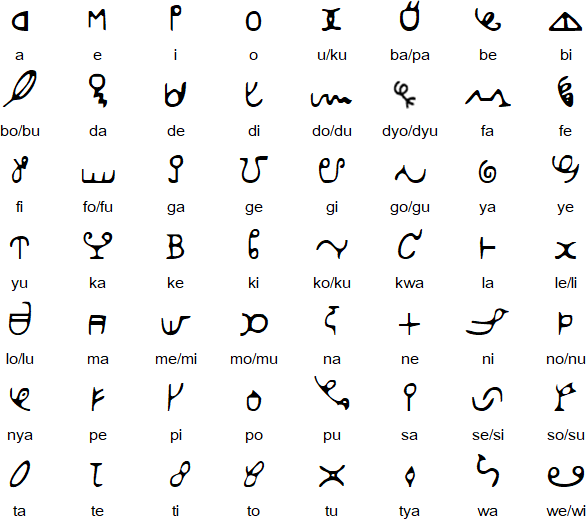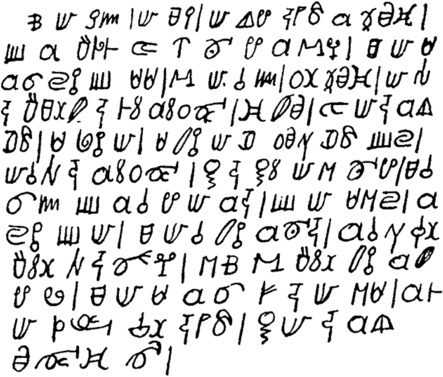The Afaka syllabary was invented by Afaka Atumisi of eastern Suriname in 1908. Afaka claimed that he had a dream in which a spirit prophesied that a script would be revealed to him. He then devised the Afaka syllabary (afaka sikifi), which is also known as the Ndjuká or Djuka script.
In 1915 a Catholic missionary in Suriname, Brother Bernard, saw a man, Afaka Atumisi's brother-in-law Abena, reading a book written in strange symbols. Abena was one of about 30 people who know the script at that time, and he told Brother Bernard about it. One of Brother Bernard's colleagues, Father Morssink, studied the script and tried to promote it, though without much success.
The Ndjuká syllabary does not represent all the sounds of the Ndjuká language, and as it became associated with European missionaries, the Ndjuká speakers saw the script as a relgious one unsuitable for everyday purposes. There was also no tradition of literacy among them. These days, Ndyuka is usually written with the Latin script. However, the Afaka script is is used in artwork by the Okanisi painter and sculptor Marcel Pinas.

Download a script chart for the Afaka Syllabary (Excel)
Download a Afaka font (TrueType format).
This is apparently the first letter written by Afaka. It was copied into the Patili Molosi Buku in about 1917.

ke mi gadu | mi masa | mi bigi na ini a ulotu |
fu a papila di yu be gi afaka | ma mi de
aga siki fu dede | fa mi sa du | oli ulotu | mi go
na pamalibo na lati ati oso | tu bolo | di mi ná abi
moni | de yaki mi | de taki mi mu oloko moni fosi |
mi sa go na ati osu | da na dati mi e begi | masa
gadu fu a sa gi mi ana | fu mi deesi | a
siki fu mi | ma mi sa taki abena | a sa kon tyali
patili go na ndyuka | eke fa patili taki a bun
gi wi | ma mi de aga pe na mi ede | ala
mi noso poli na ini ye | da mi ná abi
losutu ye |
Oh my God, my Lord, I start with the words on the paper that you've given Afaka. But I'm deathly ill. How can I say it? I went to Paramaribo, Lands Hospital, two times. Because I have no money, they chased me away. They say I must first earn money (before) I go to the Hospital. Therefore I pray the Lord God that he will give me a hand with the medicine for my illness. But I will talk to Abena. He will bring this to the Priest of the Ndyuka. So as the Father says it is good for us. But I have pain in my head. All my nose is rotting from the inside, I tell you. So I have no rest, I tell you.
Source: http://en.wikipedia.org/wiki/Afaka_syllabary
Information about Ndyuka | Afaka Syllabary | Numbers
Information about the Afaka syllabary
https://en.wikipedia.org/wiki/Afaka_syllabary
https://www.endangeredalphabets.net/alphabets/afaka/
https://www.academia.edu/72892172/How_to_Learn_Afaka
Afaka fonts
https://github.com/hmowbray/afaka-font
http://kiluvonprince.de/afaka-font/
Afaka, Bamum, Caroline Island Script, Celtiberian, Cherokee, Cypriot, Dunging (Iban), Eskayan, Hiragana, Iberian, Katakana, Kpelle, Loma, Mende (Kikakui), Mwangwego, Nüshu, Nwagụ Aneke, Vai, Yi, Yugtun
Page last modified: 13.10.24
[top]
You can support this site by Buying Me A Coffee, and if you like what you see on this page, you can use the buttons below to share it with people you know.

If you like this site and find it useful, you can support it by making a donation via PayPal or Patreon, or by contributing in other ways. Omniglot is how I make my living.
Note: all links on this site to Amazon.com, Amazon.co.uk
and Amazon.fr
are affiliate links. This means I earn a commission if you click on any of them and buy something. So by clicking on these links you can help to support this site.
[top]